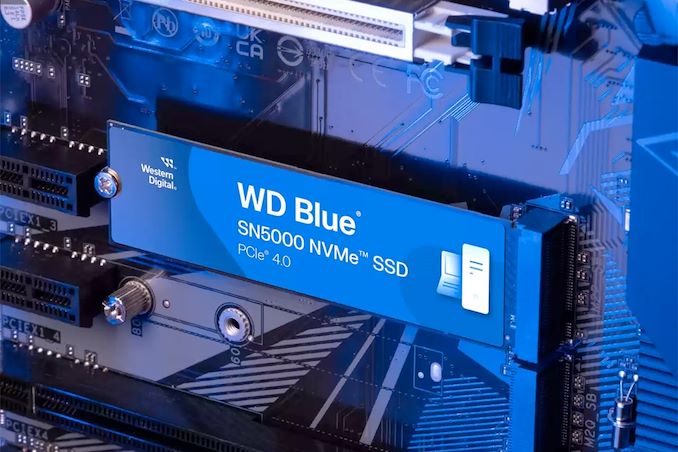Author: AnandTech

Western Digital expanded its WD Blue NVMe family of budget SSDs this week with the introduction of the the WD Blue SN5000 series, an updated lineup of SSDs that, among other things, adds a 4 TB model. Being budget drives, the SN5000 series is not going to be a performance monster, but their combination of capacity, reliability, and relatively low price could make them popular both among casual buyers and among enthusiasts looking for relatively cheap bulk solid-state storage.
Western Digital’s WD Blue SN500 NVMe drives come in an M.2-2280 form-factor and are based around an in-house WD controller (the company rarely discloses their codenames these days). WD’s controller is a 4 channel, DRAMless design, which is what we typically see for budget and mainstream SSDs. Externally, the controller supports a PCIe 4.0 x4 connection, and per WD’s specifications, even this budget drive should be fast enough to put the additional bandwidth of PCIe 4.0 to good use. All of the drives are single-sided, and are covered with a thin graphene heatspreader for heat dissipation.
More surprising here is WD’s choice of NAND. According to the company, they are using a mix of different generations and different types of NAND, depending on the model. The 500GB/1TB/2TB models are using WD/Kioxia’s older 112 layer BiCS 5 TLC NAND. Meanwhile the new 4TB capacity is being enabled with the company’s newer BiCS 6 NAND – but the QLC variety. All drive capacities are being backed by the same controller, so there is a thread of commonality between them, but at a high level WD seems to be using the higher performance of BiCS 6 to offset the switch from TLC to QLC.
WD Blue SN5000 SSD Specifications
Capacity
500 GB
1 TB
2 TB
4 TB
Controller
WD In-House: 4 Channel, DRAMless
NAND Flash
WD BiCS 5 TLC
WD BiCS 6 QLC
Form-Factor, Interface
Single-Sided M.2-2280, PCIe 4.0 x4, NVMe
Sequential Read
5000 MB/s
5150 MB/s
5150 MB/s
5500 MB/s
Sequential Write
4000 MB/s
4900 MB/s
4850 MB/s
5000 MB/s
Random Read IOPS
460K
730K
650K
690K
Random Write IOPS
770K
800K
Peak Power
6.3W?
SLC Caching
Yes
TCG Pyrite Encryption
2.01
Warranty
5 Years
Write Endurance
300 TBW
0.33 DWPD
600 TBW
0.33 DWPD
900 TBW
0.24 DWPD
1200 TBW
0.16 DWPD
When it comes to performance, the WD Blue SN5000 series drives are rated for read speeds between 5000 MB/sec and 5500 MB/sec depending on the capacity, while write speeds range from 4000 MB/sec to 5000 MB/sec. As for random performance, we are looking at up to 690K 4K IOPS random read speeds as well as up to 900K 4K IOPS random write speeds for the highest capacity model, while the lower-end 500 GB model is rated for 460K/770K 4K random read/write IOPS.
Overall, even with the 4TB model using QLC NAND, WD is touting it at offering better performance than any of the lower capacity models. We’re accustomed to seeing QLC drives come in behind TLC drives in this respect, so that newer generation of NAND is doing a lot of heavy lifting to put it ahead of the other models.
This goes for write endurance as well; the 4TB QLC model has the highest endurance rating, at 1200 TB written, followed by 900, 600, and 300 TBW for the lower capacity models respectively. Depending on the specific drive model, this works out to between 300 to 600 drive writes in total, or around 0.164 drive writes per day, which is typical for drives in this class.
Overall, the new drive family supplants WD’s previous generation of Blue drives, last year’s SN580 series. Comparatively, the SN5000 drives are rated to offer better sequential and random drive performance at every tier. And the the tiny 250GB drive has been dropped entirely, making room for the new high-capacity 4TB model at the high-end while the 500GB drive model is the new entry-level capacity.
While the WD Blue SN5000 NVMe family seems to be well positioned to be a low-cost drives meant to compete aggressively on the pricing, for now WD’s launch prices are a bit ambitious. The $70 price tag for the 500 GB version is pretty typical, while the $280 recommended price for a 4TB model puts it in a weird spot between a number of other 4TB drives. The tad slower Crucial P3 Plus 4TB can be found for $217, while WD’s own considerably faster WD_Black SN850X 4TB is only $30 more, at $310. Ultimately, given that Western Digital’s Blue drives are meant to be inexpensive SSDs, we expect retail drive prices to catch up with market realities shortly.
